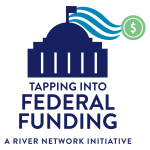$2 Billion Available Now to Advance Equitable Climate Resilience and Pollution
Across the network community-based groups are organizing to address pollution and build resilience to climate change in their communities. Now, through the Inflation Reduction Act (IRA) the EPA has launched the groundbreaking Community Change Grants Program investing an unprecedented $2 billion in environmental and climate justice activities to benefit “disadvantaged communities.” It will fund projects that reduce pollution, increase community climate resilience, and support communities in addressing environmental and climate justice challenges. The goals of this program are to fund community driven climate resilience solutions, invest in cross sectoral collaborations with partners working with and for disadvantaged communities, and to fund and empower disadvantaged communities. River Network is working to compile and share information and resources on this massive opportunity and will be hosting a learning session March 26 at 2pm EST with the Environmental Protection Network (EPN). You can register for the learning session here.
Community Change Grants Funding
The $2 billion in grant funding comes from the Inflation Reduction Act, with $200 million set aside for technical assistance. There are two tracks applicants can apply for. Track I is Community Driven Investments for Change, which holds the majority of funds at $1.96 billion. Track II is Meaningful Engagement for Equitable Governance with $40 million.
Application Deadlines
Applications are accepted through November 21, 2024. However, because applications are selected on a rolling basis, the Environmental Protection Network (EPN) advises applicants to get their applications in as soon as possible. EPA does not expect funds to be exhausted ahead of the deadline but it is possible.
Eligible Applicants
Eligible applicants must include community-based organizations in partnership with other community-based organizations, Federally Recognized Tribes, local governments, and/or an institution of higher education. Other organizations and entities may be able to participate as subrecipients and/or contractors. Projects must benefit a disadvantaged community. Disadvantaged community is defined as an identified community on the EPA IRA Disadvantaged Communities Map, a farmwork community, or a Disadvantaged Unincorporated Community. For this program, EPA also has several specific target investments it’s looking to fund:
- $150 million for Native Alaskan Tribes
- $300 million for Native Tribes in the Continental US
- $50 million for United States Territories
- $50 million for Disadvantaged Unincorporated Communities
- $100 million for Southern Border Communities
Eligible Projects
Track I has six main goals: to increase community resilience, reduce local pollution and improve public health, center meaningful engagement, build community strength, reach priority populations, and maximize integration across projects. Projects in Track I must include:
- Climate Action Strategy
- Pollution Reduction Strategy
- Community Engagement and Collaborative Governance Plan
- Community Strength Plan
- Readiness Approach
- Compliance Plan
The second track funds projects that build communities’ capacity to evaluate and redress environmental and climate injustices and that give disadvantaged communities a voice in governmental decision-making.
What makes an application competitive?
A competitive application for Track I will include a comprehensive Climate Action Strategy that builds the adaptive capacity of communities, reduces emissions, and prepares for as well as reduces the impacts of climate change. It will quantifiably reduce health harming pollutants and maintain robust community engagement from the design to the implementation of the project. It will include strategies to ensure investments reach disadvantaged communities immediately and beyond the grant period. It will reach priority applications that exhibit acute vulnerabilities to climate change and pollution. It will also ensure that projects and activities are well- integrated and complement each other’s outcomes.
A competitive application for Track II will create comprehensive strategies to give disadvantaged communities meaningful voice in governmental decision- making processes in order to build the capacity of communities to respond to environmental and climate injustices. A particularly effective proposal will also include cross-sector collaboration to facilitate the engagement of disadvantaged communities in governmental decision making.
If an application is rejected before the end of the submission period, applicants may rework, edit, and resubmit the application.
Further Learning and Resources
- EPN’s 6-step Application Guide – Suggested 6-Step Application Process for EPA’s Community Change Grants – Environmental Protection Network
- EPA’s Community Change Grant FAQ
- EPA’s Track I Checklist – Checklist (EPA Community Change Grants Track I) 2023 – Google Sheets
- EPA’s Track II Checklist – Checklist (EPA Community Change Grants Track II) 2023 – Google Sheets
- Anthropocene Alliance Find Expertise/Project Partners Spreadsheet – 2023 Find expertise/project partners (English/Spanish) – Google Sheets






